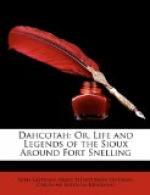The Sioux warriors formed a circle; in the centre was a pole fastened in the ground. One of the Indians killed a dog, and, taking out the heart and liver, held them for a few moments in a bucket of cold water, and then hung them to the pole. After awhile, one of the warriors advanced towards it, barking. His attitude was irresistibly droll; he tried to make himself look as much as possible like a dog, and I thought he succeeded to admiration. He retreated, and another warrior advanced with a different sort of bark; more joined in, until there was a chorus of barking. Next, one becomes very courageous, jumps and barks towards the pole, biting off a piece of the flesh; another follows and does the same feat. One after another they all bark and bite. “Let dogs delight” would have been, an appropriate melody for the occasion. They had to hold their heads back to swallow the morceau—it was evidently hard work. Several dogs were killed in succession, when, seeing some of the warriors looking pale and deadly sick, Captain E. determined to try how many of their enemies’ hearts they could dispose of. He went down among the Indians and purchased another dog. They could not refuse to eat the heart. It made even the bravest men sick to swallow the last mouthful—they were pale as death. I saw the last of it, and although John Gilpin’s ride might be a desirable sight, yet when the Sioux celebrate another dog feast, “may I not be there to see.”
Our intercourse with the Sioux was greatly facilitated, and our influence over them much increased, by the success attending my husband’s efforts to paint their portraits. They thought it supernatural (wahkun) to be represented on canvas. Some were prejudiced against sitting, others’ esteemed it a great compliment to be asked, but all expected to be paid for it. And if anything were wanting to complete our opportunities for gaining all information that was of interest, we found it in the daguerreotype. Captain E., knowing they were about to celebrate a feast he wished to paint in group, took his apparatus out, and, when they least expected it, transferred the group to his plate. The awe, consternation, astonishment and admiration, surpassed description. “Ho! Eastman is all wahkun!”
The Indians are fond of boasting and communicating their exploits and usages to those who have their confidence. While my husband has delineated their features with the pencil, I have occupied pleasantly many an hour in learning from them how to represent accurately the feelings and features of their hearts—feeble though my pen be. We never failed to gain a point by providing a good breakfast or dinner.
With the Rev. Mr. Pond and Dr. Williamson, both missionaries among the Sioux, I had many a pleasant interview and talk about the tribe. They kindly afforded me every assistance—and as they are perfectly acquainted with the language of the Sioux, and have studied their religion with the view to introduce the only true one, I could not have applied to more enlightened sources, or better authority.




